#phalaropus lobatus
Explore tagged Tumblr posts
Text

Migratory May Day 19: Red-Necked Phalarope
Reference photo by Dorian Anderson
#migratory may#red-necked phalarope#phalarope#phalaropus lobatus#phalaropus#scolopacidae#charadriiformes#bird#birb#birds#birbs#bird art#art#digital art#artists on tumblr#tw eyestrain#cw eyestrain#wauk wauk
31 notes
·
View notes
Text
BOTD: Red-necked Phalarope
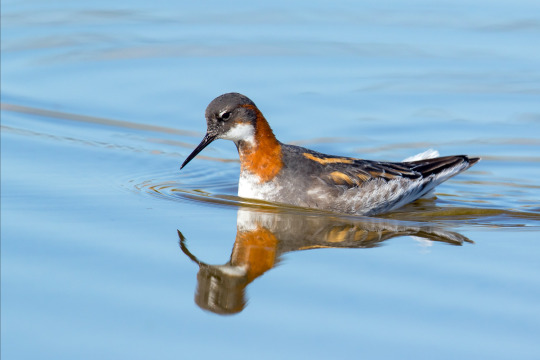
Photo: Mick Thompson
"Phalaropes reverse the usual sex roles in birds: Females are larger and more colorful than males; females take the lead in courtship, and males are left to incubate the eggs and care for the young. Red-necked Phalaropes nest around arctic tundra pools and winter at sea. During migration they pause on shallow ponds in the west, where they spin in circles, picking at the water's surface. However, most apparently migrate offshore, especially in the east. Despite their small size and delicate shape, they seem perfectly at home on the open ocean."
- Audubon Field Guide
#birds#red necked phalarope#birds of north america#north american birds#phalaropes#sandpipers#shorebirds#waders#wading birds#birds of the us#birds of canada#birds of mexico#birds of central america#birds of the caribbean#birding#birdblr#birblr#bird of the day#Phalaropus lobatus
55 notes
·
View notes
Text

Wassertreter, Phalaropus lobatus | Die Vögel (1913) | Alfred Edmund Brehm (1829-1884) | Biodiversity Heritage Library
8 notes
·
View notes
Photo

Phalaropus lobatus [アカエリヒレアシシギ,Red-necked phalarope]
人を恐れてないようで、かなり近くまで来てくれました。 凛々しい😊 在庫から。
61 notes
·
View notes
Photo

Red-necked Phalarope
29 notes
·
View notes
Photo

Red-necked Phalarope (Phalaropus lobatus)
© Michel Gosselin (MCN)
22 notes
·
View notes
Photo

Red-necked Phalarope (via U.S. Fish and Wildlife Service Headquarters)
Blackwater National Wildlife Refuge, MD
Photo: USFWS
#Red-necked Phalarope#Phalaropus lobatus#Phalaropus#Scolopacidae#Scolopaci#Charadriiformes#Aves#birds#phalarope#wetlands#Blackwater National Wildlife Refuge#Blackwater NWR#Maryland
27 notes
·
View notes
Text

Odinshane (Phalaropus lobatus)
En usædvanlig trækgæst på besøg i Hornbæk Enge ved Randers.
Red-necked Phalarope (Phalaropus lobatus)
An unusual migrant visiting Hornbæk Enge, Randers, DK.
#Odinshane#Phalaropus lobatus#Phalaropus#Red-necked Phalarope#Phalarope#Svømmesneppe#Sneppe#Scolopacidae#Fugl#Bird#Aves#Vadefugl#Vader#Wader#Shorebird#Efterår#Autumn#Fall#Hornbæk Enge#Randers#Twitch
1 note
·
View note
Photo

Red-necked Phalarope (Phalaropus lobatus) >>by Thy Photography
261 notes
·
View notes
Video
Red-necked Phalarope Grabbing a Bite by marlin harms Via Flickr: Phalaropus lobatus juvenile, Morro Creek, Morro Bay, California Phalaropes are frenetic. This bird and a number of others were constantly picking out small invertebrates (insects?) on the surface of the water. They will tank up for up to several weeks and then continue their migration, most of them going to oceanic waters off South America.
2 notes
·
View notes
Text

Day 24, "Dizzy" - Red-necked Phalarope (Phalaropus lobatus)
Phalaropes are known for their odd behavior where they spin in circles while foraging. It's kind of adorable
12 notes
·
View notes
Note
2 and 12
Wow, this took an eternity. I’m sorry. I wrote so much and had to delete most of it again because it was ridiculously long.
2. Where did you find inspiration for your muse?
Short answer: Everywhere.
Long answer:
When watching the Sabaody arc I kinda wanted to see a marine’s reaction to learning about the slavery and other… bad things. I mean, they surely don’t tell every new recruit what’s up. That would be counterproductive for their reputation, as many people probably join thinking they’ll do good in the world.
As we didn’t get any marine’s reaction I created my own: A naiive female marine that was supposed to be devastated be learning that she spent her whole life dedicated to serve people that were even worse than the monsters (read: pirates) she had fought before.
I made her a captain. But I wanted her to have tight bonds with her whole crew. Since I couldn’t make as many individual characters as there are people in a marine captains crew I pulled the idea of a small special unit out of my ass and thought about what kind of jobs were necessary on a ship. Ironically the most helpful page was one that explained how pirate crews are build.
After I decided on which jobs would be occupied, I started fleshing out the characters occupying these. Going into detail for everyone would take to much time and space, so I’ll just list the most important influences.
1. Captain, Ránar: The name is taken from norse mythology, and morphed to not be Rana anymore, since someone else already has an OC called that. The way she will go is inspired by Madsen’s Kapitän (See next question).
For the others I used patterns: Family name taken from some sea bird, first name having a meaning including water (except Don and Lani). I know, it’s not very creative but they were only meant as placeholders in the beginning but then grew on me.
Another pattern: Faces taken from some German musicians, since I guessed those weren’t used by anyone yet. NOTE: After working on them for a while they barely resemble their faceclaims anymore, so I don’t know if I can even still use the term faceclaim. But I figured it might be interesting to see where they came from.
2. First mate, Don(val) Bekassin: He is just called Don, after an older Character of mine. His Sarkasm stems from my favourite character and main spurce of entertainment of a bookseries I read: Abu Dun. He was also supposed to have very dark skin and exaggerated in size, as that character, but those characteristics then went to Toja. His family name is just Bekassine minus the “e”. Faceclaim: Adel Tawil (link)
3. Quartermaster, Nero Turnstone: I honestly don’t know, what inspired him. I guess he is what I think of the “hero saving damsel in distress” trope. Except that he never get’s the chance to be that hero and his opinion on just being strong is enough to slay the dragon (or rather defeat the oponent) won’t get him very far. His stubborness and attitude towards defeat is inspired by Equilibrium’s Unbesiegt (See next question). “Nero” is greek for water, “turnstone” a bird and his faceclaim is Peter Fox (link).
4. Ship’s doctor, Kanja Mornell: He is heavily inspired by a real live doctor I had the misfortune to meet and the XXL-East Frisian (a TV-famous guy, nicknamed bone crusher, like Kanja). Bone crusher (German: Knochenbrecher) is actually the old East Frisian term for an orthopedist for horses. The show followed him around helping horses. It often looked rough, but it was effective. The reallife doctor was feared among the people of my home town before he retired. The hopital was drastically understaffed so, if you had to do an post-operation check up you were send to him. He was unsensitive, rough, didn’t care if you were in pain because of how he treated you, just explained why and that it would soon be over. He was a former field’s doctor and people think that’s were he got his roughness from. Going there was a nightmare. When people neded to have an operation they didn’t say “I hope everything will turn out fine”, they said “I hope I don’t need check ups afterwards”… Kanja is hindi for born in the water, Mornell comes from Mornellregenpfeifer, the German name for Dotterel , his faceclaim is Lasterbalk (link)
5. Cook, Kelvin Ostrero: I wanted a scary looking chemist as a cook. His fighting style is inspired by Honey Lemon from big hero six. Kelvin is scottish for small water, Ostrero is a bird, his faceclaim is Alec Völkel (link).
6. Navigator 1, Lani Plover:
and
7. Navigator 2, Mari Plover: I wanted an amazing Navigator but was afraid he would overshadow Nami, so I devided the talent onto two Navigators that act as a unit since birth: twins. One can “read” the sky and air, the other can “read” the waters. Their background is inspired by Roman policy to demand the sons of Germanic tribe leaders as a security to keep the borders peaceful. In exchange those sons were treated as Roman citizens including military training and such. Lani is hawaiian for sky, Mari is taken from mare, Italinan for sea. (Ringed) Plover is a bird and their faceclaim is Julien Bam (link) who is rather a youtuber but he also makes music, so I let it count.
8. Gunner, Sorav Skua: He is my answere to the question: What would happen if a Kuja Pirate were to bear a son. And what would happen if that woman died someday, after teaching her son some haki. That’s basically his backstory very simplyfied. Sorav is kurdish for red water, Skua is a bird, His face claim is Samy Deluxe (link).
9. Lookout, Narius Vanell: Inspired by the concept of a “Spielmann” (translation says minstrel, but translating back it’s different). Basically a medivial folk musician or band travelling around through towns and medivial markets drinking and sleeping around and simply enjoying life. But turned gay and added some elegance and dignity. Narius also stems from the greek word for water (like Nero), Vanell is from Vanellus Vanellus, the latin name for an arefria, his face claim is Blumio (link).
10. Helmsman, Avin Triel: As mentioned in my drawtober thingies, he is basically a mix of Till Eulenspiegel, a legendary prankster, and Klaus Störtebeker, a legendary pirate. Avin is a mix of Avid, kurdish for “like water” and Avina, old high German for “the great fighter”. Triel is the German word for curlew. His faceclaim is Maximilian Schlichter (link).
11. Ship wright, Toja Lobat: As mentioned before, part of his character stems from a character I like. Mainly his statue (which I exaggerated even more), his skin colour and his soft heart. All in all he’s just a big softy with too much strength. And he’s afraid of hights because I found the thought of someone who towers over most people to be afraid of hights hilerious. Toja is “native american” (the page didn’t specify which language exactly) for flowing water. Lobat comes from Phalaropus Lobatus, latin for red-necked phalarope. His face claim is Chima (link).
12. Bosun, Yuval Avosett: No real inspiration. I wanted someone weird. That’s him. Whenever I come up with an idea for something that would be considered weird behaviour I ask myself, if I can see him doing it. If yes, it becomes part of his character. Yuval is hebrew for source of water. Avosett comes from Recurvirostra Avosetta, latin for Avocet. His face claim is Niel Mitra (link).
12. Share a song that matches with your muse!
I have only really found two so far:
Unbesiegt by Equilibrium (link) for Nero
Kapitän by Madsen (link) for Ránar
both are German, but I’m sure there are translations somewhere out there.
@askthetheateroftruthcrew
#One Piece#OC#One Piece OC#askthetheateroftruthcrew#stromriders#ask meme#ask#Ránar#Don#Nero#Kanja#Kelvin#Lani#Mari#Sorav#Narius#Avin#Toja#Yuval
2 notes
·
View notes
Photo

Red-necked Phalarope (Phalaropus lobatus). near Arnarstapi, Western Region, Iceland. June 2017.
#birds#wildlife#nature#animals#wading birds#iceland#photography#agavex-photography#2017#canon eos 750d
2 notes
·
View notes
Text
I went on a spectacularly successful pelagic birding trip last Sunday. To spare your dashboard from individual posts about each of the county year birds I added I’m going to put them all in one post, and I’ll throw in a cut to spare non-mobile dashboards from so much wonderful pelagic-birding content. 🙂
This was the long-range summer pelagic trip conducted by Island Packers, as organized by Ventura-county birder Dave Pereksta. We started from Ventura Harbor at 7 a.m., visited Anacapa Island, then motored west along the south sides of Anacapa and Santa Cruz. Once we reached the northwest corner of the Santa Cruz Basin (an area of very deep water south of the island) we headed south along the underwater escarpment that marks the basin’s western edge. Areas like that tend to be characterized by upwellings that bring nutrient-rich water to the surface, leading to more fish, marine mammals, and birds.
(Side note: I was too focused on the birds to pay much attention to the cetaceans, but we had great views of Minke, Fin, and Blue Whales, as well as several types of dolphins, during this part of the trip.)
We went south as far as a point about 7 or 8 miles north of San Nicolas Island, then turned east and headed to Santa Barbara Island. From there we made the final trip back north to Ventura, passing east of Anacapa. The whole trip took about 12 hours. About half of it was in Ventura County waters, so those birds didn’t count toward my Santa Barbara list; the other half was in Santa Barbara County.
Is it interesting to a non-county-list-obsessed person how the offshore county boundaries are drawn for bird-watching purposes? Probably not; apologies... But basically, county boundaries don’t actually exist far out in the ocean, so birdwatchers have come up with a system of assigning pelagic birding ��counties” based on whatever the closest point of land is. This makes for an interesting patchwork off southern California, since some islands (Anacapa and San Nicolas) are in Ventura County, while others (Santa Cruz, Santa Rosa, and Santa Barbara) are in Santa Barbara County. Fortunately, keeping track of all that was up to the trip leaders: Super-experienced birders who got a free ride (I assume) in return for acting as guides for the paying customers, keeping the county-specific eBird lists and helping find and identify birds.
Enough meta; on with the birds!
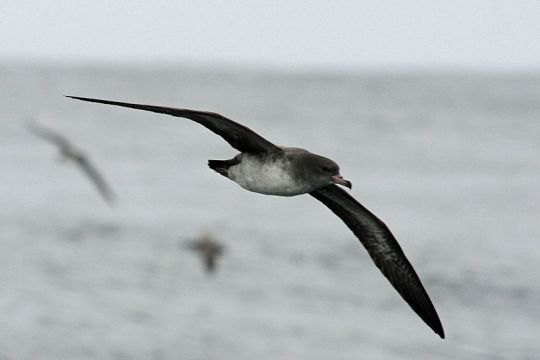
Pink-footed Shearwater (Ardenna creatopus)
Photo by Flicker user Greg Schechter
#277
We saw thousands of Sooty Shearwaters during the trip, but I’d already managed to add those to the list by scoping from shore at Ocean Beach Park west of Lompoc. The Pink-footed Shearwaters were another story, though. We saw lots of them mixed in with the Sooties, and I soon got familiar with their slightly slower flight style.
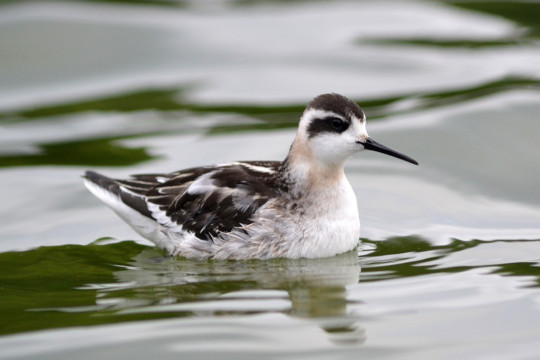
Red-necked Phalarope (Phalaropus lobatus)
Photo by Flickr user Andrew Cannizzaro
#278
We saw a few of these at various points during the trip, skittering away from the boat across the water. I’m pretty sure at least one group was in Santa Barbara County waters, though I won’t know for sure until the official trip lists are shared with participants.
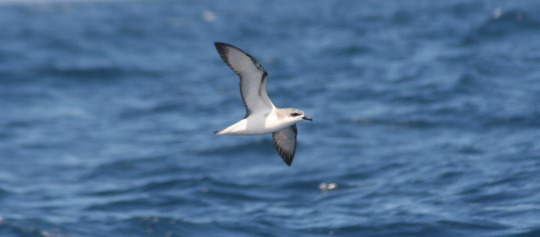
Cook’s Petrel (Pterodroma cookii)
Photo by Flickr user Duncan
#279
Such a cool bird! They breed in New Zealand, but during the Northern Hemisphere summer they range up into the eastern part of the North Pacific. Our trip leaders weren’t expecting to see them since we weren’t going to be far enough offshore, but surprise! We saw a lot of them in both counties; close to 100 in the final count. I loved getting to know their graceful, arcing flight pattern, the way they swoop down toward the water and up again, similar to but distinctly different from the shearwaters they were hanging out with.
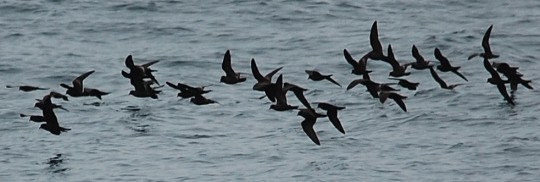
Black Storm-Petrel (Oceanodroma melania)
Image by Wikipedia user Cato Neimoidia
#280
I’d never identified a storm-petrel before. I’m sure I must have seen them, having spent so much time sailing off southern California growing up, but almost all of that time I was racing, not birdwatching, and I guess I just kept the two activities compartmentalized. Anyway, I’ve now enjoyed quality views of a whole bunch of Black Storm-Petrels; we saw lots of them throughout much the trip.
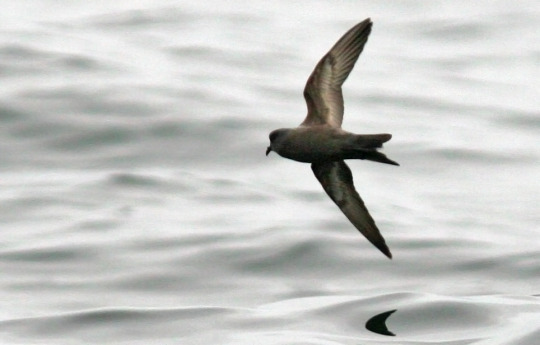
Ashy Storm-Petrel (Oceanodroma homochroa)
Photo by Jeff Poklen
#281
I was grateful to have expert birders around to help me learn these. Peter Gaede (who led our Big Pine Mountain survey trip) patiently showed me how the Black Storm-Petrels had deeper wingbeats, while the slightly smaller Ashies had quicker, shallower wingbeats. The difference was subtle, but with someone standing next to me to confirm the IDs it didn’t take long to be able to pick them out.
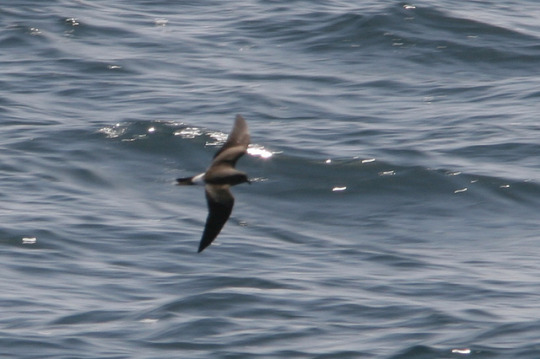
Leach’s Storm-Petrel (Oceanodroma leucorhoa)
Photo by Flickr user Marcel Holyoak
#282
Again, I was lucky to have experts around to find and point out the different storm-petrels in the big groups we motored through; I saw a few of these at various points. Some of the more-expert birders on the boat saw a few additional storm-petrel species, but I wasn’t able to get on any of those.
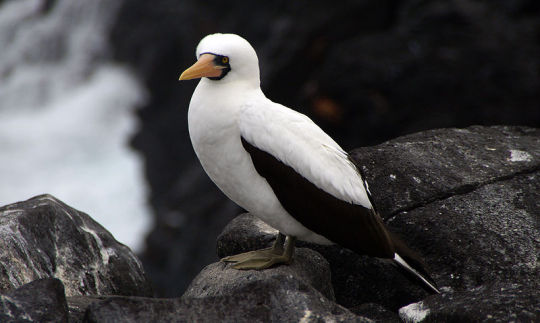
Nazca Booby (Sula granti)
Photo by Flickr user putneymark
#283
This is the bird (actually birds) that the trip leaders were most excited about. It’s a super-rarity that normally lives in the Galapagos Islands, but a few have showed up in Southern California in recent years. We saw one perched on Arch Rock on the east end of Anacapa; that one was something like the 3rd or 4th county record for Ventura County. Which was cool and all, but I couldn’t help feeling a twinge of regret that the bird hadn’t been a few miles away in Santa Barbara County. Fast-forward to late afternoon, though, as we were approaching Santa Barbara Island, when a second Nazca Booby appeared out of nowhere and flew right over the boat as dozens of giant lenses tracked it and snapped photos. Apparently that one was only the second Santa Barbara County record; it was a real privilege to be there for it. Officially the sighting will have to be approved by the California Bird Records Committee, but for my low-grade just-for-funsies county year list it definitely qualifies for now.
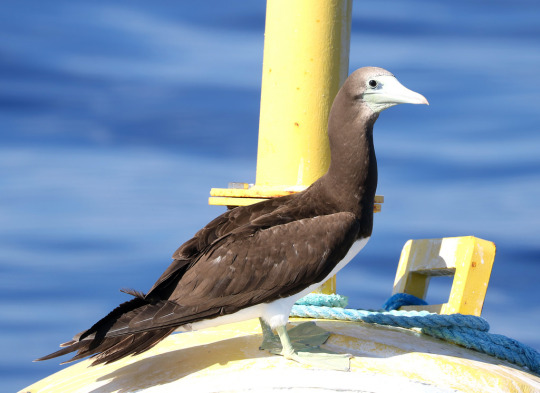
Brown Booby (Sula leucogaster)
Photo by Flickr user Alan Schmierer
#284
Another tropical species that has been expanding its range. I didn’t realize it before the trip, but last November Brown Boobies were discovered nesting on Sutil Island, a small islet a few hundred yards from Santa Barbara Island. We counted more than 40 of them perched on the rocky cliff as we bobbed a few boat lengths from shore.
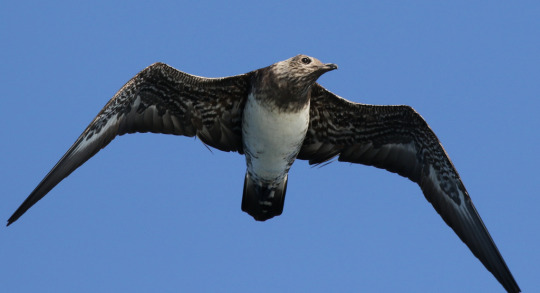
Long-tailed Jaeger (Stercorarius longicaudus)
Photo by Flickr user jacksnipe1990
#285
We saw a few of these near Santa Barbara Island; not the adult form with the long central tail plume that gives it its name, but younger birds like this one. I’ve got a soft spot for jaegers, and seeing these (we saw several) was really special.
That was it for new county year birds, but I also got some great new-to-me birds in Ventura County:
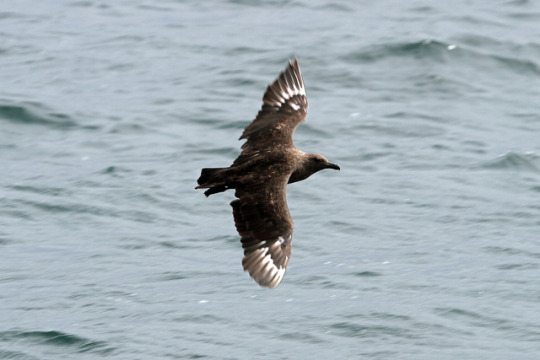
South Polar Skua (Stercorarius maccormicki)
Photo by Flicker user Greg Schechter
This one showed up to check out the chum line that professional bird guide Wes Fritz was ladling out from the stern as we cruised north of San Nicolas Island.
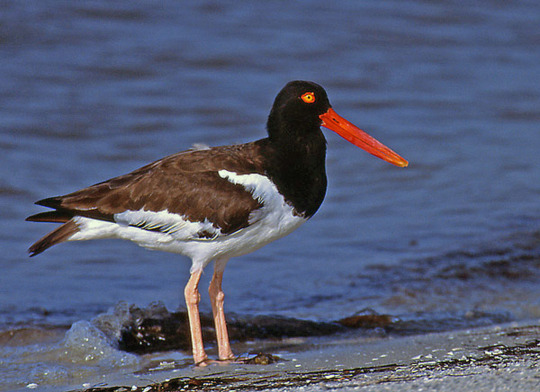
American Oystercatcher (Haematopus palliatus)
Photo by Wikipedia user Peter Wallack
One of the goals of the trip was to look for American Oystercatchers on the south shore of Anacapa, where they sometimes show up mingled with the local Black Oystercatchers. And... one was there! It’s not for-sure; hybrid American/Black Oystercatchers also tend to show up in Southern California, and there’s a complex formula called the “Jehl scale” that birders sometimes use to try to figure out how “pure” a particular American-ish SoCal oystercatcher is. I dunno; we got good looks and lots of photos of this one, and the assembled experts seemed to think the bird looked pretty good for American.
It wasn’t in Santa Barbara County, so I’m like ¯\_(ツ)_/¯
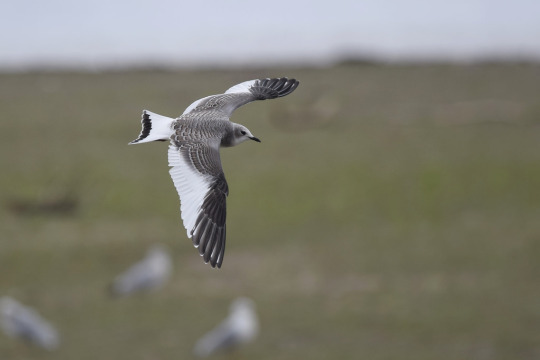
Sabine’s Gull (Xema sabini)
Photo by Flickr users Andy Reago & Chrissy McClarren
This one was a legitimate thrill for me; a bird I’d very much hoped we’d see, that I knew was a possibility but that was also far from a sure thing. It’s a pelagic gull that’s rarely seen from shore, and I was so happy to see it I didn’t even mind that it was in Ventura County.
And that’s it! On the way back the experts on the boat were fairly giddy; “one of the top 5 Southern California pelagic trips ever!” one said. I’ll take his word for it; it was only my second pelagic birding trip, so I don’t have much to compare it to.
But I sure had a good time.
10 notes
·
View notes
Photo

Phalaropus lobatus [アカエリヒレアシシギ,Red-necked phalarope]
在庫から。
44 notes
·
View notes
Photo

Best portrait category winner
Red-necked Phalarope, Phalaropus lobatus, by Saverio Gatto, Italy
Photograph: Saverio Gatto/2018 Bird Photographer of the Year
#nature#wildlife#animals#portrait#birds#aves#dance#ballet#baile#art#magnificent#red-necked phalarope#saverio gatto#italy#italia#photography#water#2018#the guardian
4 notes
·
View notes
